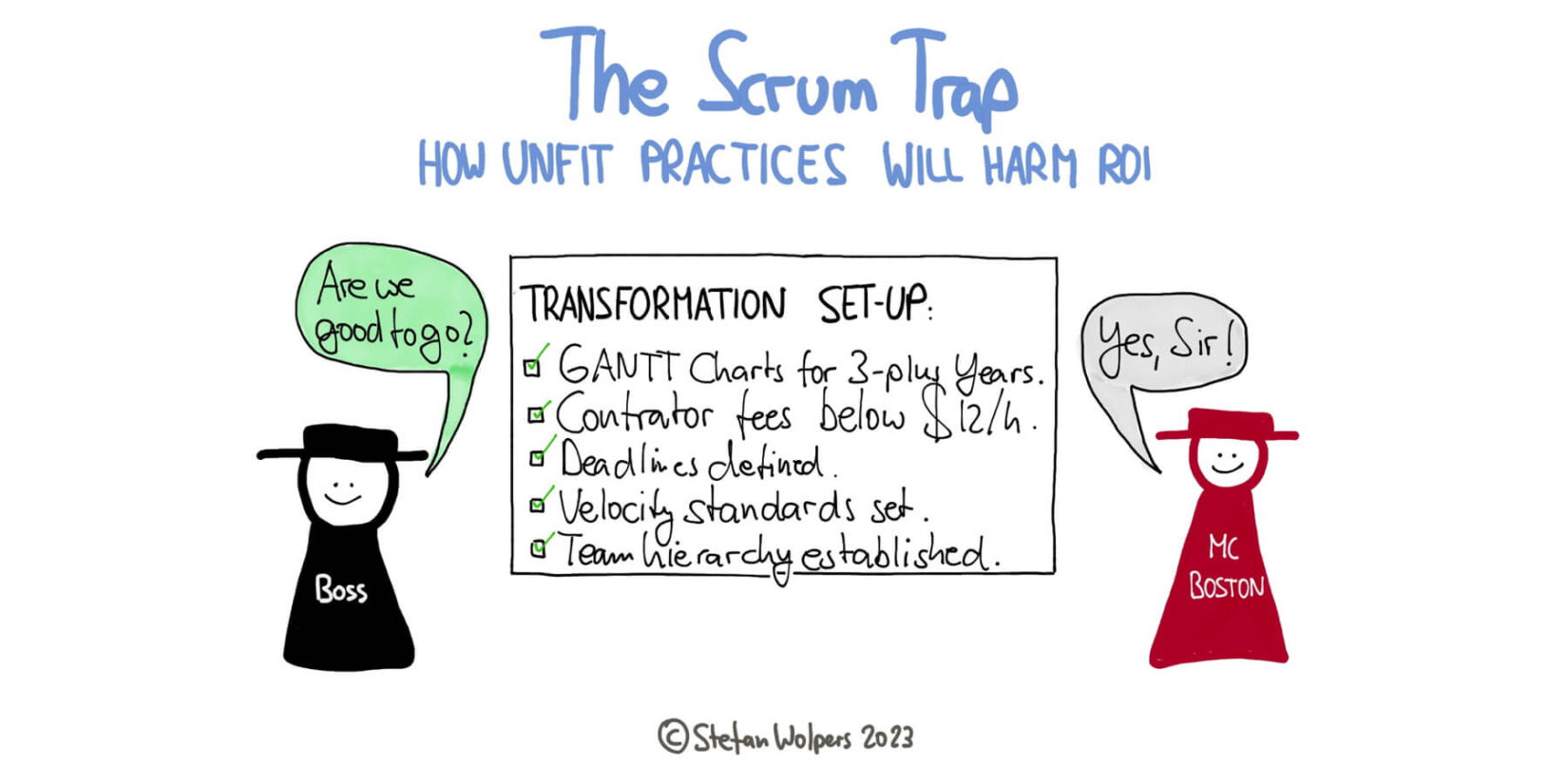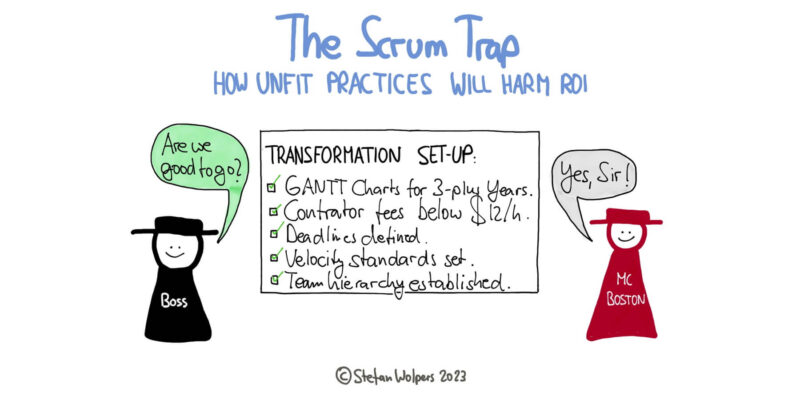TL, DR: The Scrum Trap
Scrum is a purposefully incomplete framework. Consequently, it needs to be augmented with tools and practices to apply its theoretical foundation to an organization’s business reality: what problems shall be solved for whom in which market? Moreover, there is an organization’s culture to take into account. However, the intentional “gap” is not a free-for-all to accept whatever comes to mind or is convenient. Some tools and practices have proven highly effective in supporting Scrum’s application and reaping its benefits. And then there are others — the Scrum trap.
Let’s look at what practices and tools for collaboration and team building are not helpful when used with Scrum.

📖 Preorder the Scrum Anti-Patterns Guide book now for delivery in January 2024!
🗞️ Exclusively on my Substack Newsletter: Daily Scrum Anti-Patterns — An Excerpt from the Scrum Anti-Patterns Guide (6).
🥇 The most popular discussion on LinkedIn last week was: Velocity, accurate predictions — all lies we tell ourselves. 🤬
🇩🇪 Zur deutschsprachigen Version des Artikels: Die Scrum-Falle: Wie ungeeignete Praktiken die Kapitalrendite beeinträchtigen.
🗞 Shall I notify you about articles like this one? Awesome! You can sign up here for the ‘Food for Agile Thought’ newsletter and join 49,000-plus subscribers.
🎓 Join Stefan in one of his upcoming Professional Scrum training classes!
Join the Product Backlog Management Class of Jan 23 to Feb 20, 2024; get one of five tickets 50% off with the code “PBM2024”!
Collaboration Between Stakeholders or the Management and Scrum Teams
In this category of the Scrum trap, we find numerous remnants of applying outdated industrial-age management practices:
- Applying best practices without inspection or adaptation: The Scrum principle of empiricism (transparency, inspection, adaptation) and the Agile Manifesto’s emphasis on responding to change over following a plan stress the importance of context-specific solutions. Mindlessly applying best practices from other organizations without considering their relevance to the current context will likely lead to ineffective processes.
- Upfront, long-term planning: This approach conflicts with the Agile principle of welcoming changing requirements, even late in development. Scrum promotes iterative and incremental development, allowing flexibility and adaptation in response to feedback and changing circumstances rather than rigid long-term planning. Scrum’s fast-feedback-loop approach to risk mitigation, for example, during the Daily Scrum or Sprint Review, avoids loss aversion or falling victim to the sunk cost fallacy.
- Empowering steering committees to override Product Owner decisions: This undermines the Product Owner’s role in maximizing the value of the work of their teammates. It can lead to a disconnect between the Scrum Team and the product vision, reducing the effectiveness of the Scrum framework in delivering value, starting with compromising the creation of the Product Goal.
- Outsourcing work to the lowest bidder: This can compromise the quality and consistency of the product, going against the Agile focus on continuous attention to technical excellence. Relying on outsiders to do the actual work can also disrupt the broader team dynamic within the product group and hinder the building of effective, self-organizing teams, a core aspect of Scrum.
- Keeping Scrum team members uninformed about the purpose and next steps: This practice undermines the Scrum value of openness and the Agile principle of building projects around motivated individuals. When team members are uninformed, they can’t make informed decisions or feel a sense of ownership, which is crucial for a self-organizing team. Just think of the Scrum principle that no one can tell Developers how to turn a Product Backlog item into an Increment.
- Employing Agile Coaches at the organizational level while keeping Scrum Masters confined to tactical levels: This attitude can create a disconnect between strategy and execution, limiting the Scrum Master’s ability to foster an agile mindset. The Scrum Guide emphasizes the role of the Scrum Master in promoting and supporting Scrum as understood in the entire organization. Therefore, the separation of Scrum Master and Agile Coach within an organization is artificial and unfounded in principles.
- Focus on resource utilization: This anti-pattern contradicts the Agile Manifesto’s principle of valuing “individuals and interactions over processes and tools.” Overemphasizing resource utilization can lead to burnout and reduced creativity, as it often neglects the human aspect of the development process. Scrum fosters a sustainable pace of work, encouraging teams to focus on delivering value rather than merely being busy; it is about outcome, not output.
- Applying arbitrary deadlines to improve worker efficacy: This can lead to rushed and lower-quality work, contradicting the Agile focus on sustainable development, maintaining a constant pace indefinitely, and dedication to technical excellence. Arbitrary deadlines also undermine team morale and creativity, which are crucial for innovation and problem-solving in a Scrum environment.
This section highlights critical anti-patterns in collaboration between stakeholders and Scrum Teams that are at odds with Scrum’s flexibility, empowerment, and innovation principles. The next stop is team building.
Team Building — The Scrum Trap
Let’s look at what practices and tools in collaboration and team building are not helpful when used with Scrum, leading you directly into the Scrum trap:
- Creating feature teams focused on output (à la Marty Cagan): This approach can shift focus from delivering value to merely completing tasks. The Scrum framework and Agile principles emphasize outcome over output, advocating for delivering products that provide real value to users rather than just completing features. In a complex environment, merely shipping more Product Backlog items per Sprint does not necessarily create more value.
- Distinguishing openly between regular employees and freelancers or temporary workers: This practice can create divisions within the team, undermining the Scrum values of respect and openness. Scrum thrives on cross-functional teams where all members are equally valued for their contributions. Such distinctions can hinder team creation, cohesion, and collective ownership. Moreover, it increases the probability that stakeholders are less interested in building relationships with freelancers, as the return on investment may be limited from their perspective.
- Empowering regular employees to decide on employing freelancers: This can lead to biases, a lack of diversity in perspectives, and less transparency. Scrum encourages collective decision-making and values diverse input to foster creativity and innovation. Decisions about team composition should be made collaboratively, reflecting the team’s needs and the product vision. Empowering regular employees creates a power differential within the team, where freelancers may become mercenaries, mainly interested in prolonged employment.
- Employing freelancers only with short-term contracts: This can disrupt team continuity and knowledge sharing, which are critical for a Scrum Team’s effectiveness. Short-term engagements may not allow enough time for freelancers to fully integrate into the team and contribute meaningfully, contradicting the Agile Manifesto’s emphasis on motivated individuals and team interaction. Moreover, it often is a stepping stone to create “Scrum Teams” focused on output due to a higher fluctuation rate among team members.
- Accepting line managers assigning new members to Scrum teams without consent: This undermines the principle of self-organization central to Scrum. Teams should have a say in their composition to ensure the right mix of skills and a strong sense of team unity. Moreover, when the management includes Scrum Teams in hiring, they will go the extra mile to make things work, as they have skin in the game.
- Accepting line managers instruct team members directly: This breaks the Scrum principle of self-management and can lead to micromanagement. It disrupts the empowerment of the Scrum team to make decisions, which is essential for its practices to be effective.
- Creating a functional hierarchy within the Scrum Team with “lead” roles: Scrum is remarkably egalitarian. Consequently, this approach goes against the flat structure advocated by Scrum, where all team members are considered equals, contributing to all aspects of value creation. Hierarchies can stifle creativity, hinder collaboration, and reduce transparency, essential elements of an effective Scrum Team.
- Creating a reporting hierarchy within Scrum teams: This can develop a sense of inequality and reduce open communication, reflecting the power differential, thus contradicting the Scrum values of courage and respect. Scrum promotes a collaborative environment where all team members share equal responsibility for the product’s success.
- Not investing in regular and comprehensive training of Scrum team members: This neglects the continuous improvement aspect of Scrum. Regular training ensures that team members stay updated with the latest practices and technologies, enhancing their ability to deliver high-quality products and embody the Agile principle of continuous attention to technical excellence and good design. It is a sound business decision, too, as there is no business agility with technical excellence.
This Scrum trap segment explores anti-patterns in Scrum Team building, undermining Scrum’s values of equality, self-organization, and continuous improvement, negatively impacting team cohesion and overall effectiveness, thus lowering the return on investment from an organizational perspective.
Food for Thought
Consider the following questions to help your organization to avoid the Scrum trap and embrace agility fully:
- How can organizations effectively balance the need for structure and the flexibility required by Scrum, especially in traditionally hierarchical or rigid corporate cultures?
- In what ways can Scrum teams navigate the challenges of integrating freelancers and temporary workers, ensuring they contribute effectively while maintaining team cohesion and continuity?
- How can Scrum Masters and Agile Coaches work together to bridge the gap between tactical team management and strategic organizational goals, particularly in large or complex organizations?
Conclusion
Augmenting Scrum is a challenging task. It requires careful selection of practices and tools, acknowledging and abandoning outdated management tactics, and emphasizing the importance of first principles of agility and team cohesion. Failing to do so will undermine Scrum’s core values and principles, ultimately impeding its effectiveness in delivering value and fostering innovation—an unsound business decision.
Pre-Order the Scrum Anti-Patterns Guide Book on Amazon Now!
PS: The Scrum Anti-Patterns Guide book is now available for pre-order: Check out US, UK, and DE. Click the banner to be directed to your local Amazon store. (Handled by Genius Link; includes an affiliate link at no cost to you.)
The Scrum Trap — Related Articles
Three Essential Agile Failure Patterns in 7:31 Minutes—Making Your Scrum Work #12
Agile Failure Patterns in Organizations 2.0
All posts on Scrum Anti-Patterns
Download the Scrum Anti-Patterns Guide for free
📅 Scrum Training Classes, Workshops, and Events
Learn more about how to avoid the Scrum trap with our Scrum training classes, workshops, and events. You can secure your seat directly by following the corresponding link in the table below:
See all upcoming classes here.
You can book your seat for the training directly by following the corresponding links to the ticket shop. If the procurement process of your organization requires a different purchasing process, please contact Berlin Product People GmbH directly.
✋ Do Not Miss Out and Learn more about the Scrum Trap — Join the 19,000-plus Strong ‘Hands-on Agile’ Slack Community
I invite you to join the “Hands-on Agile” Slack Community and enjoy the benefits of a fast-growing, vibrant community of agile practitioners from around the world.
If you like to join all you have to do now is provide your credentials via this Google form, and I will sign you up. By the way, it’s free.
Support your team’s efforts to avoid the Scrum trap by pointing to the free Scrum Anti-Patterns Guide:





